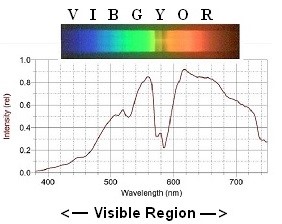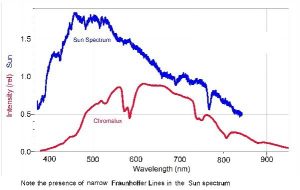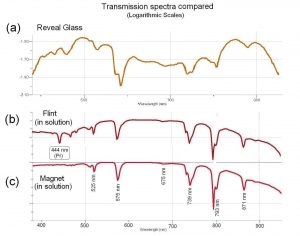Roscoe C. Bowen, Peter A. Adcock, Sara Bonaccorsi, and Jean Oostens
Introduction.
A physicist visiting a health food store in the 1990s was intrigued to find a new kind of incandescent light bulb that claimed to have the ability to trick a person’s brain into stopping the production of melatonin in the morning, even when the days are short. This bulb, named Chromalux®, claimed to provide a “full spectrum” light, thanks to the use of “pure neodymium”. The physicist decided to pay the hefty $8 or so for a single bulb, in order to investigate how they got the neodymium into the bulb and what its spectrum was really like. It was first considered that neodymium might have a melting point higher than that of tungsten, the element that had replaced Edison’s carbon filament of the early days of electrical lighting.
That explanation did not hold long: a look in a reference on the properties of elements revealed that neodymium melts at 1021° C against 3407° C for Tungsten (1). It was discovered that the neodymium was not found in the filling vapors or the filament. It was also not deposited on the inner surface of the glass, but incorporated intimately within the structure of the glass. Herein, we interpret the “use of pure neodymium” to mean use of pure neodymium (III) oxide as source material for incorporation in neodymium glass.
The Chromalux® bulb was developed in Finland where the long winter nights disturb people’s circadian cycle. These extensive periods of darkness produce an excess of melatonin, the hormone regulating the waking and sleeping parts of the day (2). Normally, the production of melatonin ceases under the influence of sunlight, rich in blue. The perception by the eye of such a blue-rich light could be obtained just as well by blocking the complementary color, yellow. Later, General Electric introduced a similar bulb under the name Reveal® [reproduced in Figure 1]. Its glass is seen by transparence as blue/violet.

This experience led our investigator to remember the history of neodymium, an element discovered in 1885 in Vienna by Baron Karl Auer von Welsbach (1), of gas light fame.
History and Uses of Neodymium.
Neodymium is element number 60 in the periodic table of the chemical elements. As such, it is a member of the lanthanide series (58-71), named after lanthanum (element 57). Originally, this series was called the “rare earth elements”, though it turns out that some are not that rare. From the middle of the nineteenth century, this was an exciting field, where chemists and spectroscopists discovered these fourteen chemically similar elements, one by one (1).
Many of the lanthanides were extracted from a crudely refined material termed mischmetal. This material is still used today in flints for cigarette lighters and strikers for the chemistry lab. However, the technical history of neodymium is aligned with its magnetic properties. Like iron, neodymium, samarium (element 62), gadolinium (element 64) and holmium (element 67) are ferromagnetic, albeit only at much lower temperature (being lost at characteristic temperatures between -253° C for Holmium and 16° C for Gadolinium) (3). However, by proper alloying, each can be used to make permanent magnets. In the twentieth century, there was a great appetite for permanent magnets, because they are important components of electric motors, as well as loudspeakers.
In the search for better permanent magnets, chromium, cobalt, and nickel were considered and many of their alloys were tried. “Alnico” (aluminum-nickel-cobalt) was once the favorite: in the years just before World War II, it replaced the “field coil” that provided the large magnetic field needed for radio loudspeakers. The field coil required typically 5 watt (100 volt x 0.050 amp) to be provided by the high voltage DC power supply. The more powerful alnico permanent magnets did away with that requirement, allowing the popularization of smaller radios, including battery-operated ones.
In the post-war period, ion exchange chromatography allowed better separation of specific lanthanides from their neighbors in the periodic table. Alloying purified samarium with cobalt, made an even better, but more expensive magnetic material than alnico (4).
The large-scale use of neodymium in magnets began in 1982. An alloy of formula Nd2Fe14B, was developed by Sumitomo Special Metals (4) for motorized windows and other gadgets in cars made by General Motors. This alloy provided a large magnetic field with a much smaller mass than was needed previously.
Around the year 2000, hybrid cars made their inroads into the market. A typical hybrid car needs about 1 kg of neodymium for its electric motor (4), and a full electric car would require several times that amount. Thus it is expected that the demand for neodymium may increase considerably as hybrid and electric cars become more popular.
Rationale for an Undergraduate Experiment
David Hestenes, in his “Modeling Method” training sessions (5) insisted that “Spectroscopy is the language of the stars, learn it well”. The same could be said not only about stars, but also about atoms and molecules. This calls for this physics-based analytical method to be introduced early enough to motivate the students’ interests in both disciplines.
In the laboratory exercise described here, one of us (Bonaccorsi), a student majoring in chemistry at Campbellsville University, used spectroscopy to discover the presence of neodymium in three consumer products. The student’s experiment and some follow-up investigations are described in the following more technical section of this paper.
Spectroscopic Identification of Neodymium: An Undergraduate Experiment
In our search for a suitable experiment to achieve the stated purpose, we found three household items where the presence of neodymium could be detected by its characteristic absorption in the visible region. As seen in Figure 1, qualitative observations are possible using a simple diffraction grating, but the complete quantitative inquiry described here requires a digital Vis/near IR spectrometer.
A question that one may want to deal with is: Is the advertised “full spectrum” feature of the original Chromalux® bulb credible? To test this, one should compare the emission spectrum of the bulb with the one of the sun, as shown in Figure 2.

It appears clearly that the Chromalux® bulb has its maximum at much higher wavelength than in the case of the Sun. In other words there is much more blue light in the Sun. Also the dip around 580 nm for the Chromalux® lamp, which is characteristic of the presence of neodymium, translates as less yellow light being transmitted through the glass. According to the sensitivity of human vision, this causes the light to be perceived as having more of the complementary color, blue/violet.
For a closer examination of the glass itself, an inexpensive GE Reveal® bulb is broken from which a small piece is selected to insert in the transmission accessory of the spectrometer. Then one dissolves either a small (3 mm diameter) neodymium magnet or a lighter flint in about 6 mL of 6M HCl. Using the spectrometer in the Transmission Mode for all three experiments, we find the transmission spectra seen in Figure 3.

In all three spectra, most of the dips occur at the wavelengths reported in the literature (6-8). The flint and the magnet have very similar features, while the glass dips are wider and less marked.
For the flint, the additional dip at 444 nm corresponds to praseodymium (8), an impurity one could expect in flints. A neodymium magnet would require a better purified material without detectable praseodymium.
Further Inquiry.
The above procedures can fit into a regular three-hour lab session. If a more advanced experience is desirable, a small research-type assignment could use this experiment as a springboard. Topics that could be investigated are:
- Study the splitting of the absorption dips when using a different acid (HNO3 or H2SO4) to dissolve the magnet and the flint. If NdCl3 is available, use an organic solvent (e.g. ethyl alcohol).
- Test magnetically collected materials (nominally magnetite) for Neodymium content.
- Obtain commercial sample of mischmetal and test this for praseodymium content.
- Compare the temperature of the glass for two comparable incandescent bulbs, with and without neodymium.
- If a higher resolution spectrometer is available, compare a clear glass bulb with a Reveal® model of the same power. Which one gives the most light? Can the student identify the inert gas that may be present in either bulb?
Acknowledgments.
We thank our colleagues in the Natural Science Division of Campbellsville University, especially Kay Sutton and Chris Mullins for their help in locating supplies for some wet chemistry experiments.
The contributions of an anonymous reviewer were instrumental in making this article more reader-friendly.
References and Footnotes:
1) Emsley, John. The Elements. Oxford University Press: New York, 1989.
2) The possible effects of short wavelengths of light on the body’s circadian clock can be found in an excellent review (up to 2008) of research on circadian rhythms and the effect of melatonin: Blue Light Specials by Jacob Schor, ND, FABNO. http://denvernaturopathic.com/bluelightandmelatonin.htm
3) Serway, Raymond A., Moses, Clement J., & Moyer, Curt A. Modern Physics, 2nd ed. Saunders College Pub.: Fort Worth, TX, 1997.
4) Su, Andrew. The World’s Most Attractive Magnet that is not Attracting Attention. Illumin [Online] 2014, XV(1), http://illumin.usc.edu/printer/233/the-worlds-most-attractive-magnet-that-is-not-attracting-attention (accessed March 18, 2014).
5) Robinson, Keith. Spectroscopy: The Key to the Stars: Reading the Lines in Stellar Spectra. Springer: New York/Heidelberg, 2007. Quoted by David Hestenes in “Modeling Summer School” Arizona State University, 1997-98.
6) Adams, John W. The Visible Region Absorption Spectra of Rare Earth Minerals. Am. Mineral. 1965, 50, 356-366
7) Stewart, D.C. and Kato, D. Analysis of Rare Earth Mixtures by a Recording Spectrophotometer. Anal. Chem. 1958, 36(2), 164-172.
8) George, S. and Shafiran, H. Absorption spectra of rare earths—A demonstration and an experiment Am. J. Phys. 1997, 65, 352-354.
Peter A. Adcock, a Visiting Professor of Chemistry at Ross-Hulman Institute of Technology, taught chemistry at Campbellsville University from 2004 to 2011. His interests lie in chemical and electrochemical processes and in teaching chemistry. From 2001 till 2004, he did post-doctoral research in a fuel cells group at Los Alamos National Lab in New Mexico. He has also undertaken research at Northeastern University, the Australian National University, and Murdoch University. Adcock earned his Ph.D. at the University of Western Sydney, Australia.
Sara E. Bonaccorsi is Associate Chemist at ConAgra Foods in Omaha, NE. She is a 2006 graduate of Campbellsville University.
Roscoe C. Bowen is Associate Professor of Exercise Science at Campbellsville University. He received a Ph.D. from Drexel University.
Jean Oostens has enjoyed a distinguished career as educator and researcher in his native Belgium, in France, and in the United States, with positions in Saclay (France), University of California at Los Angeles and Berkeley, Illinois Institute of Technology in Chicago, University of Cincinnati, Lindsey-Wilson College, and Campbellsville University. He holds a Ph.D. in physics from the University of Paris-Sud. Now retired, Oostens continues to be active in research at the Los Alamos Research Laboratory and is Secretary of the Science Teachers Alliance, South-Central Kentucky.
